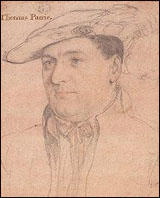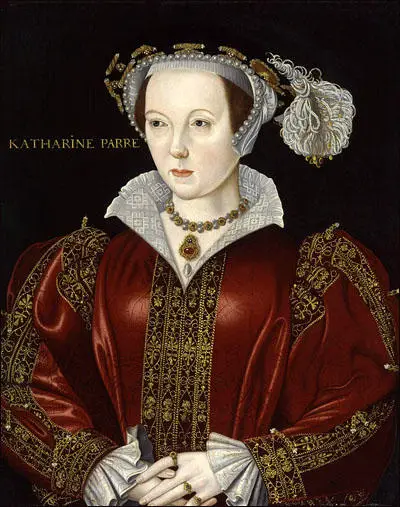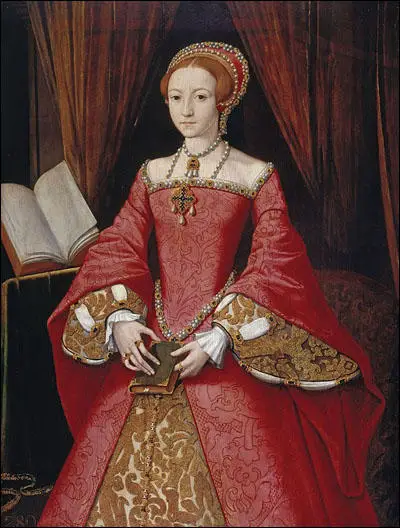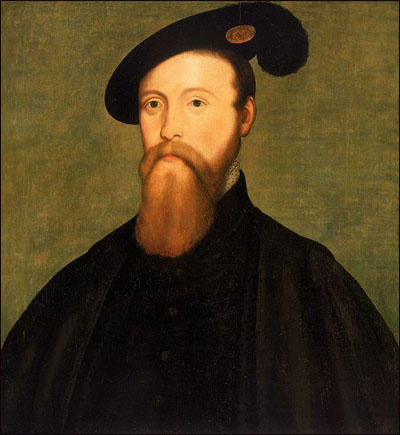Thomas Parry

Thomas Parry, the son of Sir Henry Vaughan of Tretower, and his wife, Gwenllian, daughter of William ap Grono of Brecon, was born in about 1515. According to his biographer, Jonathan Hughes: "He was born into a much intermarried group of Anglicized Welsh gentry who flourished under the Tudors; the fact that he was known by the Christian name of his father (though he later softened the form from ap Harry to Parry in order to secure acceptance at the court of Edward VI) probably indicates that he was born and brought up in Wales." (1)
In 1536 he entered the service of Thomas Cromwell. A protestant in religion, he was employed in that year and later to visit religious houses with Cromwell's instructions for their dissolution. In about 1540 he married Anne Fortescue, whose husband, Sir Adrian Fortescue, had been executed for treason in July 1539.
Parry joined the household of Princess Elizabeth and eventually became her cofferer (treasurer). After the death of her father, Henry VIII, on 28th January, 1547, Elizabeth, accompanied by Katherine Ashley, her governess, went to live with his widow, Catherine Parr. Henry's only son, Edward VI was only nine years old and was too young to rule. In his will, Henry had nominated a Council of Regency, made up of 16 nobles and churchman to assist Edward VI in governing his new realm. Edward Seymour, Duke of Somerset, emerged as the leading figure in the government and was given the title Lord Protector. His brother, Thomas Seymour, Lord Sudeley, proposed to the Council that he should marry the 13-year-old, Elizabeth, but he was told this was unacceptable.
Thomas Seymour
Seymour now set his sights on Catherine Parr. At the time he was described as "being gifted with charm and intelligence... and a handsome appearance". (2) Just a few weeks after Henry's death Catherine wrote to Seymour: "I would not have you think that this mine honest good will toward you to proceed from any sudden motion of passion; for, as truly as God is God, my mind was fully bent, the other time I was at liberty, to marry you before any man I know. Howbeit, God withstood my will therein most vehemently for a time, and... made that possible which seemed to me most impossible." (3)
| Spartacus E-Books (Price £0.99 / $1.50) | ||||||
|---|---|---|---|---|---|---|
The historian, Elizabeth Jenkins, believes that the "Queen Dowager, released from the sufferings of her marriage to Henry VIII, behaved like an enamoured girl." (4) Seymour wanted to marry Parr but realised the Council would reject his proposal, as it would be pointed out that if she became pregnant, there would have been uncertainty about whether the child was Seymour's or Henry's. (5) Seymour married Parr in secret in about May 1547.
Seymour visited Parr in her home in Chelsea before the news of their marriage was announced. This created extra problems as Elizabeth and Lady Jane Grey were also living with Parr at this time. (6) It has been pointed out that "Elizabeth was still only thirteen when her stepmother, of whom she was most fond, married for love. The young Princess remained in her care, living principally with her at her dower houses at Chelsea and Hanworth. Ever curious and watchful, Elizabeth could not fail to have noted the effects of the sudden transformation in Catherine Parr's life. From patient, pious consort of an ailing elderly king she had been transmuted into a lover, desired and desiring." (7)
Princess Elizabeth
Catherine Parr, who was now thirty-five, became pregnant. Although she had been married three times before, it was her first pregnancy. It came as a great shock as Catherine was assumed to be "barren". (8) Seymour now began paying more attention to Elizabeth. Katherine Ashley, Elizabeth's governess, later recorded: "Seymour... would come many mornings into the Lady Elizabeth's chamber, before she were ready, and sometimes before she did rise. And if she were up, he would bid her good morrow, and ask how she did, and strike her upon the back or on the buttocks familiarly, and so go forth through his lodgings; and sometime go through to the maidens and play with them, and so go forth... If Lady Elizabeth was in bed, he would... make as though he would come at her. And he would go further into the bed, so that he could not come at her." On one occasion Ashley saw Seymour try to kiss her while she was in bed and the governess told him to "go away for shame". Seymour became more bold and would come up every morning in his nightgown, "barelegged in his slippers". (9)

According to Elizabeth Jenkins, the author of Elizabeth the Great (1958) claims that the evidence suggested that the "Queen Dowager took to coming with her husband on his morning visits and one morning they both tickled the Princess as she lay in her bed. In the garden one day there was some startling horse-play, in which Seymour indulged in a practice often heard of in police courts; the Queen Dowager held Elizabeth so that she could not run away, while Seymour cut her black cloth gown into a hundred pieces. The cowering under bedclothes, the struggling and running away culminated in a scene of classical nightmare, that of helplessness in the power of a smiling ogre... The Queen Dowager, who was undergoing an uncomfortable pregnancy, could not bring herself to make her husband angry by protesting about his conduct, but she began to realize that he and Elizabeth were very often together." (10)
Jane Dunn has controversially argued that Elizabeth was a willing victim in these events: "Although not legally her step-father, Thomas Seymour assumed his role as head of the household and with his manly demeanour and exuberant animal spirits he became for the young Princess a charismatic figure of attraction and respect. Some twenty-five years her senior, Seymour in fact was old enough to be her father and the glamour of his varied heroic exploits in war and diplomatic dealings brought a welcome worldly masculinity into Elizabeth's cloistered female-dominated life.... Elizabeth was also attractive in her own right, tall with fair reddish-gold hair, fine pale skin and the incongruously dark eyes of her mother, alive with unmistakable intelligence and spirit. She was young, emotionally inexperienced and understandably hungry for recognition and love. She easily became a willing if uneasy partner in the verbal and then physical high jinks in the newly sexualised Parr-Seymour household." (11)
In the autumn of 1548 Katherine Ashley, the princess's governess, expressed to Parry her concerns about the sexual attentions to which the princess was being subjected by Thomas Seymour. "Kate had seen Seymour embracing Elizabeth, and despite her complaining to Katherine, the abusive relationship continued; on one occasion the husband and wife together visited the princess in her bed and tickled her, on another they cut her dress into pieces. Parry swore himself to secrecy" (12) "He would rather be pulled with horses than he would disclose it". (13)

Sir Thomas Parry, later testified that Thomas Seymour loved Elizabeth and had done so for a long time and that Catherine Parr was jealous of the fact. In May 1548 Catherine "came suddenly upon them, where they were all alone, he having her (Elizabeth) in his arms, wherefore the Queen fell out, both with the Lord Admiral and with her Grace also... and as I remember, this was the cause why she was sent from the Queen." (14) Later that month Elizabeth was sent away to stay with Sir Anthony Denny and his wife, at Cheshunt. It has been suggested that this was done not as punishment but as a means of protecting the young girl. Philippa Jones, the author of Elizabeth: Virgin Queen (2010) has suggested that Elizabeth was pregnant with Seymour's child. (15)
Elizabeth wrote to Catherine soon after she left her home: "Although I could not be plentiful in giving thanks for the manifold kindness received at your highness' hand at my departure, yet I am something to be borne withal, for truly I was replete with sorrow to depart from your highness, especially leaving you undoubtful of health. And albeit I answered little, I weighed it more deeper when you said you would warn me of all evils that you should hear of me; for if your grace had not a good opinion of me, you would not have offered friendship to me that way that all men judge the contrary. But what may I more say than thank God for providing such friends to me, desiring God to enrich me with their long life, and me grace to be in heart no less thankful to receive it than I now am glad in writing to show it. And although I have plenty of matter, here I will stay for I know you are not quiet to read." (16)
Catherine Parr gave birth to a daughter named Mary on 30th August 1548. After the birth, Catherine developed puerperal fever. Her delirium took a painful form of paranoid ravings about her husband and others around her. Catherine accused the people around her of standing "laughing at my grief". She told the women attending her that her husband did not love her. Thomas Seymour held her hand and replied "sweetheart, I would do you no hurt". Seymour is reported to have lain down beside her, but Catherine asked him to leave because she wanted to have a proper talk with the physician who attended her delivery, but dared not for fear of displeasing him. (17)
The fever eventually went and she was able to dictate her will calmly, revealing that Seymour was the "great love of her life". Queen Catherine, "sick of body but of good mind", left everything to Seymour, only wishing her possessions "to be a thousand times more in value" than they were. Catherine, thirty-six years old, died on 5th September 1548, six days after the birth of her daughter. (18)
Katherine Ashley later claimed that Elizabeth took the news very badly. She refused to leave her bed and for the next five months she was unable to go more than a mile from the house. (19) Elizabeth wrote to Thomas Seymour thanking him for sending the physician, Dr. Thomas Bille, to attend to her. However, rumours began to circulate that the reasons that Elizabeth was housebound was because she was pregnant and that those around her were protecting her by alluding to her illness. (20)
Arrest of Thomas Seymour
Thomas Seymour sought to win Edward's affection and gain acceptance as his intimate adviser. He regularly visited Edward's bedchamber. Antonia Fraser has claimed: "He showed no greater greed than the rest of the nobility round him. Seymour's real weakness was his morbid jealously of his elder brother Somerset, whose military victories had first marked him out before his position as Protector raised him up." (21)
When his brother, Edward Seymour, Duke of Somerset, discovered what was happening he "put a special watch on all doors leading into the king's privy chamber in order to prevent Sudeley's clandestine entry". One night Thomas found the door to Edward's bedchamber bolted; enraged, he shot dead the king's barking dog. Somerset was given copies of letters that Sudeley had been passing to Edward. "Somerset found such correspondence intolerable" and ordered his brother's arrest in January, 1549. (22)

Elizabeth's governess, Katherine Ashley, and Sir Thomas Parry, the head of Elizabeth's household, were also arrested and interviewed by Sir Robert Tyrwhitt. They both provided accounts of Thomas Seymour's relationship with Elizabeth. On 22nd January, 1549, Tyrwhitt had a meeting with Elizabeth. He reported to Edward Seymour "all I have gotten yet is by gentle persuasion, whereby I do begin to grow with her in credit... this is a good beginning, I trust more will follow." (23)
Under interrogation, on 9th February 1549 Parry revealed all he knew about Seymour's relationship with Elizabeth. "But on the crucial point concerning Elizabeth's intentions regarding marriage to Seymour (and so defying the terms of Henry VIII's will) the investigators could find nothing.... Kate Ashley, who then made a similar confession... When Elizabeth was informed in February 1549 that Parry had told the council about his conversation with Seymour about her estates and disclosed more intimate details of her relationship with Seymour, she kept her head." Apparently, on hearing the news she called him a "false wretch". (24)
On 28th January, Elizabeth wrote a letter to the Lord Protector denying that she was pregnant: "Master Tyrwhit and others have told me that there goeth rumours abroad which be greatly both against my honour and honesty, which, above all other things, I esteem, which be these, that I am in the Tower, and with child by my Lord Admiral (Thomas Seymour). My lord, these are shameful slanders, for the which, besides the great desire I have to see the king's majesty, I shall most heartily desire your lordship that I may show myself there as I am." (25)
The Lord Protector wrote back to her to say that if Elizabeth could identify anyone who uttered such slanders against her, the Council would have them punished. Elizabeth replied that she was unwilling to accuse specific people but suggested a better plan of action: "It might seem good to your lordship, and the rest of the council, to send forth a proclamation into the countries that they refrain their tongues, declaring how the tales be but lies, it should make both the people think that you and the council have great regard that no such rumours should be spread of any of the King's majesty's sisters (as I am, though unworthy) and also that I should think myself to receive such friendship at your hands as you have promised me, although your lordship showed me great already." (26)
Sir Robert Tyrwhitt attempted to discover if Katherine Ashley, Elizabeth and Sir Thomas Parry were involved in what was described a "marriage plot" with Thomas Seymour. However, they all refused to confess and Tyrwhitt reported, "They all sing the same song and so I think they would not do, unless they had set the note before." However, without confessions, Tyrwhitt was forced to release Ashley and Parry but Seymour was charged with 39 articles of treasonable activities, including that he "had attempted and gone about to marry the King's Majesty's sister, the Lady Elizabeth, second inheritor in remainder to the Crown." (27)
Thomas Seymour was examined on 18th and 23rd February but refused to answer unless his accusers stood before him. (28) Seymour demanded an open trial to face his accusers but this was denied. To prevent his brother, Edward Seymour, from showing leniency, the Council gained permission to act without the Lord Protector's authorization. On 20th March, 1549, Seymour was beheaded on Tower Hill. Even on the scaffold, Seymour refused to make the usual confession. Bishop Hugh Latimer commented: "Whether he be saved or no, I leave it to God, but surely he was a wicked man, and the realm is well rid of him." (29)
When she heard the news, it is claimed Elizabeth commented: "This day died a man of much wit and very little judgment." Elizabeth Jenkins, the author of Elizabeth the Great (1958) has pointed out: "If the words are apocryphal their tenor shows the effect of her beating. No one who saw her doubted the intensity of her emotion: they merely admired the fortitude with which she restrained it." (30)
Elizabeth forgave Parry for his betrayal and he was reinstated by September 1549. (31) Elizabeth and Parry both benefited from the execution of Edward Seymour on 22nd January, 1552. (32) This included receiving some of his lands. Parry represented Wallingford three times in parliament. When Elizabeth was imprisoned by Mary I following the uprising led by Sir Thomas Wyatt, Parry managed her estates. "Parry defied Queen Mary's specific instructions by keeping Elizabeth in touch with the outside world and so maintaining her political connections." (33)
Parry on 20th November 1558, three days after Elizabeth's accession, Parry was made controller of the new queen's household, and with William Cecil, now the queen's secretary, was a member of the Privy Council which presided over a protestant religious settlement that restored the royal supremacy. Parry played an important part in the 1559 parliament, sending at least fifteen bills to the House of Lords.
Thomas Parry died on 15th December 1560.
Primary Sources
(1) Philippa Jones, Elizabeth: Virgin Queen (2010)
Kat Ashley and Thomas Parry were arrested and taken to London. Sir Robert Tyrwhitt remained at Hatfield to take a statement from Elizabeth, a task he found increasingly onerous. At first Elizabeth "was marvellous abashed and did weep very tenderly a long time" when she heard that Parry and Kat Ashley had been arrested. Elizabeth acknowledged she had written to Thomas Seymour regarding the help he was to give her in getting Durham Place back. She also recalled that Kat had written to him to warn him against visiting "for fear of suspicion", and that she had been angry with her Governess for being so presumptious.
Student Activities
Henry VIII (Answer Commentary)
Henry VII: A Wise or Wicked Ruler? (Answer Commentary)
Henry VIII: Catherine of Aragon or Anne Boleyn?
Was Henry VIII's son, Henry FitzRoy, murdered?
Hans Holbein and Henry VIII (Answer Commentary)
The Marriage of Prince Arthur and Catherine of Aragon (Answer Commentary)
Henry VIII and Anne of Cleves (Answer Commentary)
Was Queen Catherine Howard guilty of treason? (Answer Commentary)
Anne Boleyn - Religious Reformer (Answer Commentary)
Did Anne Boleyn have six fingers on her right hand? A Study in Catholic Propaganda (Answer Commentary)
Why were women hostile to Henry VIII's marriage to Anne Boleyn? (Answer Commentary)
Catherine Parr and Women's Rights (Answer Commentary)
Women, Politics and Henry VIII (Answer Commentary)
Historians and Novelists on Thomas Cromwell (Answer Commentary)
Martin Luther and Thomas Müntzer (Answer Commentary)
Martin Luther and Hitler's Anti-Semitism (Answer Commentary)
Martin Luther and the Reformation (Answer Commentary)
Mary Tudor and Heretics (Answer Commentary)
Joan Bocher - Anabaptist (Answer Commentary)
Anne Askew – Burnt at the Stake (Answer Commentary)
Elizabeth Barton and Henry VIII (Answer Commentary)
Execution of Margaret Cheyney (Answer Commentary)
Robert Aske (Answer Commentary)
Dissolution of the Monasteries (Answer Commentary)
Pilgrimage of Grace (Answer Commentary)
Poverty in Tudor England (Answer Commentary)
Why did Queen Elizabeth not get married? (Answer Commentary)
Francis Walsingham - Codes & Codebreaking (Answer Commentary)
Sir Thomas More: Saint or Sinner? (Answer Commentary)
Hans Holbein's Art and Religious Propaganda (Answer Commentary)
1517 May Day Riots: How do historians know what happened? (Answer Commentary)




